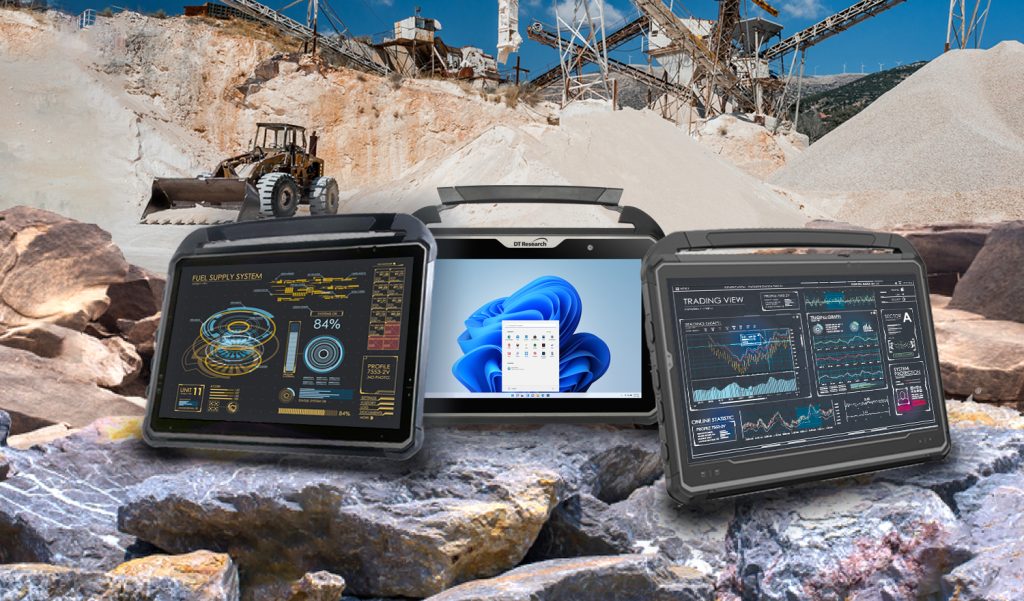
The way we build is changing as a result of the growing use of rugged tablets in the constantly evolving construction industry. Rugged tablets are proving to be one of the most useful, long-lasting, and innovative tools on contemporary construction sites, with applications ranging from integrating with digital twin models to enhancing sustainability throughout building and road construction projects.
From a standard remodel to a complex development construction project, having rugged tablets on the job site helps improve communication and can significantly reduce construction time and building costs.
Digital Twin in the Real World
Digital twin technology—the creation of a real-time, virtual model of a physical asset—is an invaluable platform for modeling and improving products, services, and processes—and, of course, buildings—and it’s transforming construction. Digital twins also allow teams to simulate scenarios, monitor changes, and optimize operations throughout a building’s or road’s lifecycle. But to make digital twins truly effective, they must be continuously updated with accurate field data. That’s where rugged tablets come in.
On-site data collection, analysis, and transmission by employees guarantees that digital twins are always up to date. Rugged tablets maintain digital twin ecosystems functioning properly, eliminating the need to carry around delicate or power-hungry equipment for tasks like examining structural elements in a commercial building or checking elevations on a roadbed. With built-in GPS, cameras, 3D scanning capabilities, and secure cloud connectivity, rugged tablets serve as the perfect bridge between field and office.
Built Tough for Construction Conditions
Unlike standard commercial tablets, rugged tablets are purpose-built for outdoor and industrial use. They are designed to operate even with rough handling, drops, dust, vibration, water exposure, and extreme temperatures—all common conditions in both road and building construction environments.
The rugged tablet’s durability translates directly to efficiency. There’s less downtime from damaged devices, fewer interruptions when working in harsh weather, and more confidence when moving between indoor and outdoor tasks. On large infrastructure projects, such as highway expansions or high-rise developments, even minor delays or equipment failures can add up to big costs. Rugged tablets help keep teams focused and projects on track.
Sustainability Through Smart Technology
Sustainability in construction is not just a buzzword—it’s a requirement. Rugged tablets contribute to greener, environment-friendly, and responsible building practices in several ways, such as:
- Paper Reduction
One of the most instant benefits is the drastic reduction in paper usage. Construction plans, blueprints, checklists, and permits can all be stored and reviewed digitally through rugged tablets. This not only minimizes waste but also prevents errors from outdated documents being used in the field.
- Remote Monitoring and Collaboration
Rugged tablets allow site managers, engineers, and stakeholders to collaborate in real time, from anywhere. From a standard remodel to a complex development construction project, rugged tablets reduce the need for frequent site visits, lowering transportation emissions and overall project carbon footprint.
- Precise Resource Management
Integrated with BIM (Building Information Modeling) systems and digital twin platforms, rugged tablets help ensure materials are used efficiently. Teams can identify and predict design clashes, material overages, or inefficiencies at the onset of the construction project— preventing costly and wasteful rework.
- Extended Device Lifespan
The longer a device lasts, the less environmental impact it has. Rugged tablets are made to last years, reducing e-waste compared to consumer-grade electronics that are often disposable.
Road and Building Projects That Benefit Most
Road construction teams use rugged tablets to log geospatial data, monitor equipment diagnostics, and mark progress along large stretches of terrain. Combined with drone mapping, tablets can give supervisors a clear, updated overview of highway or bridge projects with minimal on-foot surveying.
In building construction, architects and field engineers use rugged tablets for everything from verifying measurements against 3D models to managing subcontractors and performing safety checks. Their portability makes them ideal for navigating both scaffolding and site offices.
Construction is becoming smarter, more digital, and more sustainable — and rugged tablets are playing a central role in that transformation. They empower teams with real-time access to digital twin data, reduce reliance on outdated paperwork, and support better environmental practices from start to finish.
As construction companies continue to prioritize resilience, accuracy, and sustainability, rugged tablets will remain essential tools, not just for today’s job sites but for the future of building and infrastructure development.

